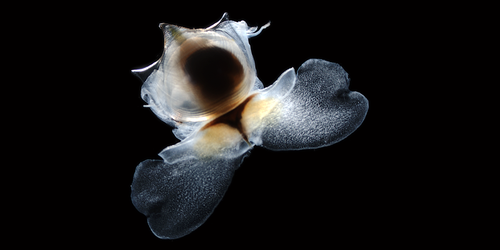The Gap-Free Helices of Sea Snails
With flapping, wing-like appendages that extend from their foot, sea butterflies are some of the stranger inhabitants of the world’s oceans. These creatures, which are actually swimming snails, typically have translucent, calcified shells with complex microscopic structures. Now Julyan Cartwright of the University of Granada, Spain, and colleagues have confirmed that the shells of at least two families of these creatures are formed of helical filaments of calcium carbonate [1]. The team proposes that these twisty microstructures develop from liquid-crystalline precursors.
Interest in helically patterned systems was ignited recently, as materials containing such coiled structures have been found to be more robust to damage—the tortuous helices make it difficult for cracks to propagate, adding significant strength. Such helical structures were first found in the calcareous shells of mollusks 50 years ago, but it was unclear exactly how they form.
Cartwright and colleagues used a scanning electron microscope to image fracture surfaces of shells from four sea butterfly species. They found layered structures with cross sections matching those expected for “space-filling” helices—helices with no empty space between their coils.
The shells of these mollusks are known to grow via the addition of rod-like units to the shells’ undersides. Previous experiments using simple analogs of these units produced certain patterns seen in liquid crystals made of similar rod-shaped particles. Such liquid crystals can form a helical phase resembling the microstructure seen in sea butterfly shells, but this phase has yet to be replicated in the analog systems. The team hypothesizes that, in nature, proteins and other molecules in the liquid under the shell push the system into the parameter regime for that phase. The rod-containing liquid then mineralizes, locking in the helical structure.
–Katherine Wright
Katherine Wright is the Deputy Editor of Physics Magazine.
References
- K. Berent et al., “Helical microstructures in molluscan biomineralization are a biological example of close packed helices that may form from a colloidal liquid crystal precursor in a twist-bend nematic phase,” Phys. Rev. Mater. 6, 105601 (2022).





